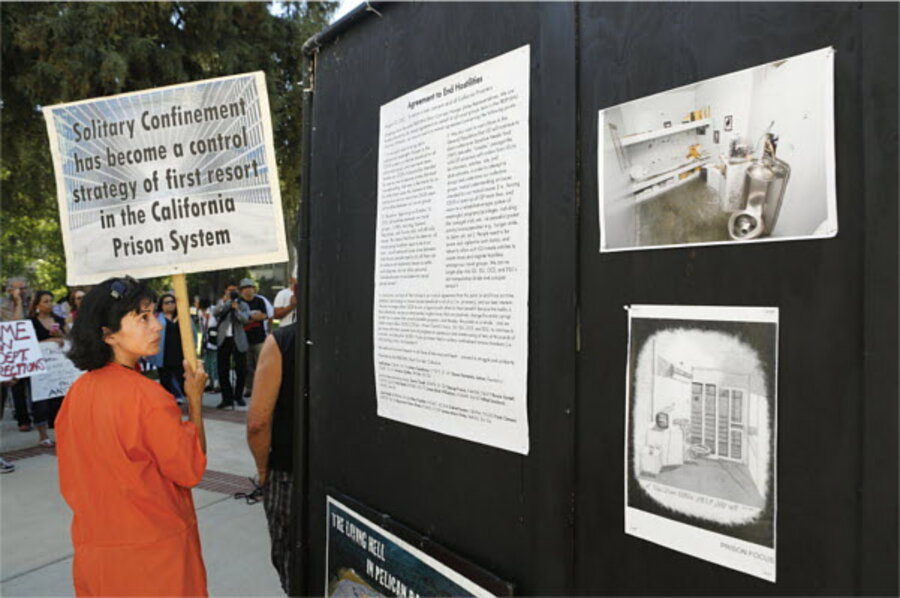California allowed to force-feed hunger-striking prisoners, judge rules
Loading...
| SACRAMENTO
California authorities won court approval on Monday to force-feed some prisoners on a hunger strike after officials voiced concerns that inmates may have been coerced into refusing food in a protest against the state's solitary confinement policies.
U.S. District Court Judge Thelton E. Henderson, responding to a request by state authorities, ruled that California prison doctors may force-feed select inmates near death, even if they had previously signed orders asking not to be resuscitated.
Some 136 California inmates are currently taking part in a hunger strike that began July 8 in prisons statewide to demand an end to a policy of housing inmates believed to be associated with gangs in near-isolation for years. Some 69 of the striking inmates have refused food continuously since the strike began.
This is the second time prisoners have launched a hunger strike to protest the state's practice of housing some inmates for years in its four Security Housing Units.
About 4,500 prisoners were housed in the units when the strike began, officials said. State officials say the units are needed to stem the influence of prison gangs – and in fact, administrators have repeatedly characterized the hunger strike as a power grab by gang leaders.
But the state's policy of housing prisoners for years in these units has been condemned by a number of human rights organizations, including Amnesty International. And at least one prisoner on the hunger strike has said that he is willing to die to make his point that the detentions are inhumane.
The hunger strike is the latest problem to plague the state's prison system, which is under federal court order to reduce crowding by the end of the year, possibly by releasing up to 10,000 inmates early.
The hunger strike launched last month has already gone on twice as long as a similar protest in 2011 and has attracted more prisoners – 30,000 at its peak – although numbers have since dramatically dwindled.
Now well into a second month without food, dozens of inmates have been sent to hospitals, officials said.
Prior to the judge's decision on Monday, California policy prohibited force-feeding of inmates on a hunger strike if they had signed medical orders refusing resuscitation in the event they lost consciousness or experienced heart failure.
But officials went to court to seek permission to ignore these "do-not-resuscitate" orders for inmates who signed them during the hunger strike or just prior to it, citing concerns about possible coercion.
Henderson wrote in his order that in view of those concerns, a "do not resuscitate" order signed by such inmates would be "deemed not valid."
ERRING ON THE SIDE OF LIFE
A lawyer for some of the hunger strikers said she was not aware of inmates being coerced.
"They're exaggerating this," said inmate advocate Carol Strickman, adding that the state should not ignore inmates' wishes in such matters of life and death. "As much as I don't want to see anybody die, some people were choosing to sign those requests and some were not."
Joyce Hayhoe, a spokeswoman for the federal receiver in charge of medical care in the prisons, said Monday's request to invalidate the more recent "do-not-resuscitate" orders was not made on an emergency basis, and that no one was force-fed on Monday as a result.
Rather, she said, officials were trying to be proactive, so the new rules would be in place as inmates continued to become sick from refusing food.
"Inmates can deteriorate rather quickly when they have starved themselves for this long period of time so we wanted to make sure we had the order in place ... for us to be able to save their lives," Hayhoe said.
Hayhoe conceded that some of the "do-not-resuscitate" orders put in place during the hunger strike were submitted after prison medical officials advised inmates that this was the only way to avoid force-feeding. But she said officials with the Department of Corrections had presented compelling evidence that some inmates had indeed been coerced.
"It's better to err on the side of life," she said.
Hayhoe said she had talked to two inmates at California State Prison, Corcoran, who refused food or medical care because they were afraid other prisoners would find out if they didn't.
All three groups involved in a years-long lawsuit over conditions in the prisons signed on to the request to invalidate the "do-not-resuscitate" orders – the lawyers who brought a suit challenging the poor medical care and overcrowded conditions, the federal receiver, and state prison officials.
(Editing by Cynthia Johnston and Eric Walsh)







